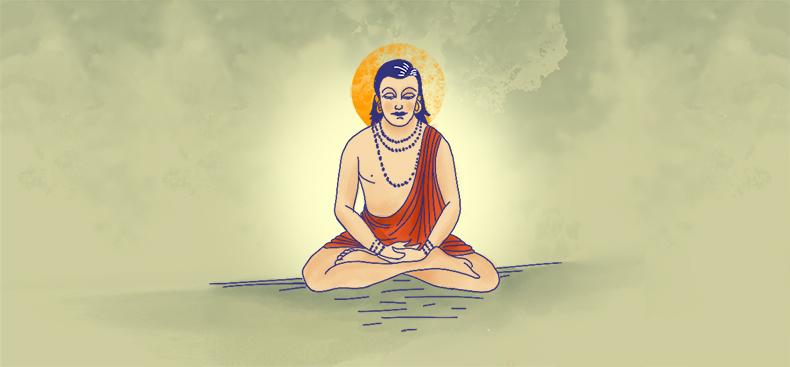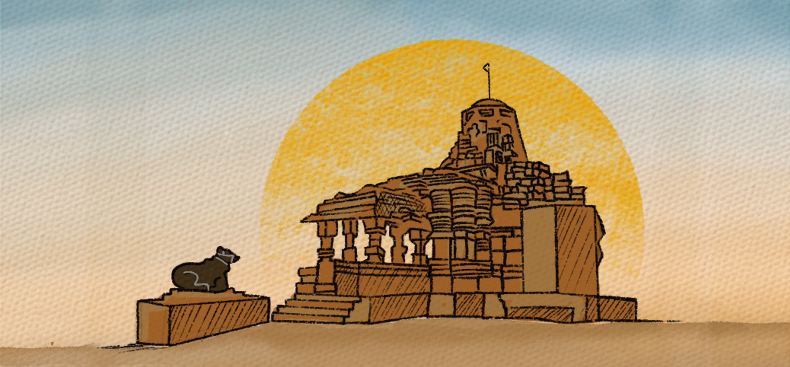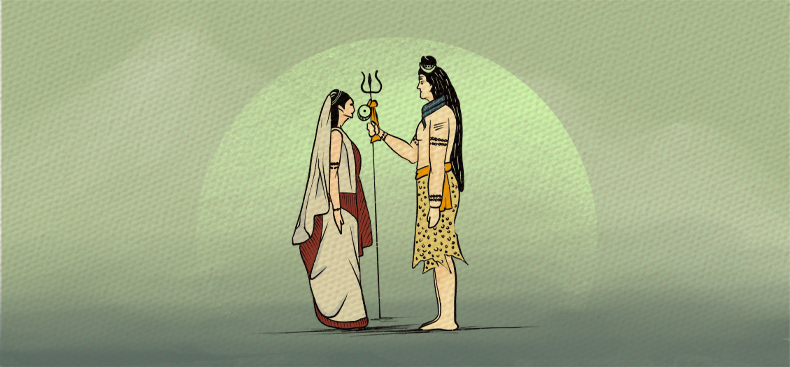Though the practices of these texts differ, the goal is the same: to achieve liberation or, in some instances, to achieve siddhis (powers). It seems that the different traditions of early yoga were in competitive tension with each other, each attempting to prove that their method is the quickest or the easiest means of reaching liberation. Amanaska Yoga was one such early text that taught the method of achieving the state of no-mind (a-mana), calling its method Rājayoga, the king of all yoga. The text is divided into two parts—the first part, it seems, was appended later, while the second part is the older of the two. Below, we will describe and summarize this very important text and its role in the evolution of various yogic practices.
Śāmbhavi Mudra
This short text is a dialogue between Śiva and the sage Vāmadeva, in which Śiva reveals the knowledge of Rājayoga to Vāmadeva for the benefit of mankind. Rājayoga is defined as a state of no-mind (and hence the name a-manaska) that is equivalent to the state of liberation (samādhi). Unlike the sequential eight limbs of Patañjali yoga, this text only focuses on the last limb, samādhi. The goal of the practice is to reach a state of detachment in which the mind is completely extinguished from the stains of thought constructs or mental impressions.
To achieve this state of no-mind, it teaches a practice called the śāmbhavi mudra. The description of the practice is very short, as the text claims that this secretive practice can only be taught and practiced through the guidance and blessings of a living guru. In śāmbhavi mudra, the yogi fixes his gaze outwards about one hand distance away, with his eyes half-closed, half-open, while directing his mind at some internal focal point which may be at the back of the head, top of the head, between the eyebrows or any other place advised by the guru. The regular practice of gazing outside but focusing inside results in complete cessation of mental fluctuations, and a state where the mind ceases to exist—a state of pure awareness. This is the highest state of yogic bliss according to Amanaska Yoga.
Detailing the practice further, Amanaska states that, before beginning, the yogi should find a quiet place and position himself in a comfortable erect posture. He should make the body tranquil by gently focusing his awareness throughout the body from head to toe, with a steady and tranquil mind (susthira citta). Forsaking all worries and completely dispassionate towards all sense stimuli, he should practice the śāmbhavi mudra. In this practice, the text claims, there is no effort. If the mind wants to run somewhere, the practitioner should let it run—any effort to control the mind will only agitate it further. Whenever there is effort, there is cognition of “I” ness, and no meditation is successful in this state of duality. The text claims that with regular practice the mind, after wandering around, will eventually come back to the internal focal point.
Elaborating, Amanaska says that breath and mind are connected just like milk and water (the link between breath and mind was first mentioned in the 7th century BCE text Chāndogya Upaniṣad 6.8.2). If the breath is active in the body, the mind will always fluctuate, and a fluctuating mind is not conducive to reach the higher states of meditation. If the mind can be controlled, then the breath can automatically be controlled and vice versa. In contrast to most haṭhayoga texts, which focus on controlling the breath to achieve higher states of awareness, Amanaska focuses on controlling the mind, and states this will eventually lead to the complete control (and cessation) of breath. Therefore, the state of no-mind is also a state where the yogi can get absolute control over his breath because liberation is not possible without immobilizing the breath. Precisely how the cessation of breath occurs during the practice, and for how long, is not mentioned in the text.
Amanaska criticizes other practices such as prāṇayāma, asceticism (tapas), consumption of elixir, reading of scriptures etc. as ways of reaching the state of liberation. It says that with the regular practice of śāmbhavi mudra under the guidance of a guru, the yogi reaches a state free from intention (saṇkalp) and action. In this liberated state, the yogi has destroyed all the meritorious and unmeritorious karma. Any new action performed by the yogi does not bind him, he is free from the taints (vāsanās) of karma. The liberated yogin remains in a state of complete bliss, dispassionate towards sense-objects, detached, and in a state of no-mind which is natural, pure, and unchanging. In short, he is liberated while living (jīvanmukta), free from the circle of life and death.
Conclusion
Amanaska Yoga calls its yoga Rājayoga, which, according to the text, is not only a method of yoga but also the name for the highest state of liberation. The idea that Rājayoga is the highest state of yogic liberation, first articulated in Amanaska Yoga, became the dominant theme in later yogic literature. There are multiple yoga texts which teach different kinds of yoga—haṭhayoga, mantrayoga and layayoga—but claim that these yogas are to be practiced to reach the state of Rājayoga. For example, in the canonical Haṭhayogapradīpika 2.76, the author Svātmarāma claims that haṭhayoga is necessary to gain success in rājayoga. Even Swami Vivekananda called his system of Patañjali aṣṭāṅgayoga a form of Rājayoga. Be that as it may, Amanaska yoga is the earliest text to use the term Rājayoga and expound the important yogic technique of śāmbhavi mudra—a secret revelation of Śiva that is now openly taught in multiple meditation and yoga schools across India.
(For readers interested in reading this text, there are two editions of Amanaska Yoga available: one in Hindi translation published by Gorakhnath Mandir, Gorakhpur and the other with English translation by the Lonavala Yoga Institute).




Leave a Reply